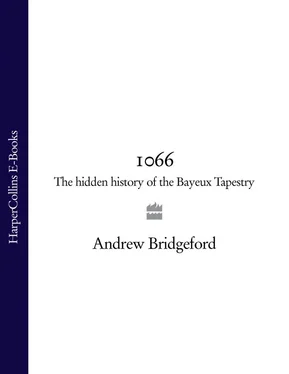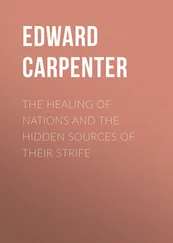The truth is very different, and it is much more extraordinary. It has emerged only slowly over the last fifty years half-hidden in the dry journals and dusty tomes of academia. Much remains mysterious, and not all specialists are in agreement, but there are very good reasons to believe that the Bayeux Tapestry was not made in Normandy at all but in conquered England, probably within about a decade of 1066, and that the ingenious master artist, who drew the designs for a team of English embroiderers, produced a dangerously many-layered masterpiece. The result is brilliantly conceived, and full of hidden meaning. Only superficially does it support the Norman story. It is a testament to the ingenuity of the artist that so many ensuing generations have failed to notice that his agenda was in reality subversive. Working under the domination of the Normans, he designed the embroidery in a way that, superficially, would not displease the conquerors; however, at the deeper level he tells us a very different story. At a time when it was not possible to record the English view in writing the artist did so pictorially. What could not be said could at least be shown, subtly and ingeniously; and a work of art that the Normans could accept and admire was in reality a Trojan horse within which the English viewpoint was ingeniously preserved. There is thus another story stitched in these pictures, a story that we must rediscover. It is a subversive account in which the Norman claim to the English throne, and much of the propaganda that the Normans were circulating, is systematically contradicted. 2Far from being Norman propaganda, the Bayeux Tapestry is more like a long-lost version of the Anglo-Saxon Chronicle. At last we can begin to unravel this hidden story and in the process astonishing new light can be shed on the dark background to Duke William’s pretension to the English throne in 1066.
In the same vein, it is often assumed that since the Bayeux Tapestry shows the Norman victory, it must be a Norman work. Mention la Tapisserie de Bayeux to a French person and you will often encounter a look of complete bewilderment. Mention la Tapisserie de la Reine Mathilde (Queen Matilda’s Tapestry) and you are much more likely to be greeted with a smile of recognition. Old legends can be very enduring. There was once a romantic notion, first recorded in the eighteenth century, that the Bayeux Tapestry owes its origin to William’s proud and admiring wife, Queen Matilda. She and her busy handmaidens, so it was said, embroidered the work in order to celebrate William’s recent achievement in conquering the English. This notion has long been abandoned by historians (in France as much as anywhere else) but the old name has proved uncommonly difficult to displace in the popular French mind. A plaque bearing the words La Tapisserie de la Reine Mathilde is still fixed to the wall outside the museum in Bayeux where the tapestry is kept, presumably because numerous French visitors continue to arrive at its gates in the full expectation of seeing Queen Matilda’s handiwork.
It is undeniable that the Bayeux Tapestry shows the Norman victory; the victory itself could not be denied. We shall see how the master artist set about subtly recording the English version of events that led up to the Norman Conquest, but more than that he sought to understand the Conquest in terms of the deeply held religious and metaphysical beliefs of his time. It was a tenet of eleventh-century Christianity that all great events were caused by the will of God. Thus, in seeking to explain how England came to be conquered by the Normans, the artist looked for guidance to the Old Testament scriptures and in the final analysis he sought to rationalise the subjugation of England as a divine punishment for sin. This was how the helpless, conquered people attempted to understand what had happened to them; the Normans, too, claimed God on their side. Yet there is a twist to all this; and the full implications of this twist have never truly been grasped. The artist appears to have been a supporter of Count Eustace II of Boulogne, a French count who, though he joined Duke William’s invasion in 1066, was in other respects a rival to the Normans in the power games of northern France. He may even have had his own claim to the English throne. Generally misunderstood and wrongly called a ‘Norman’ in almost all popular accounts, Count Eustace of Boulogne was merely a lukewarm ally of Normandy and he was on the whole deeply distrusted by Duke William. Yet in the tapestry only three persons, Bishop Odo of Bayeux, Duke William of Normandy and Count Eustace of Boulogne, are named on the Norman side as being present at Hastings, and of these three Count Eustace, of all people, seems to be given the starring role [plate 11]. Particularly close attention must be paid to the career of this ambitious and powerful Frenchman. The perspective of Boulogne, too long forgotten, ignored or misunderstood, holds some of the Bayeux Tapestry’s most beguiling secrets. The quest of this book is to attempt to unravel these and other millennial mysteries of the work.
2 A Tale of Consequence: The Impact of Conquest
Today the walls of eleventh-century buildings, such as survive, are cold and bare and they give nothing away of the brightness and luxuriance that once clothed them within. Were we to be transported back in time, however, and to step inside some of the great churches or secular palaces of the day, it would not be long before we encountered bright and colourful hangings draped around interior walls, as well as painted murals and other decoration on the stonework itself. Thus in the great Anglo-Saxon poem Beowulf a secular hall is described as resplendent with drapes, ‘embroidered with gold’ and picturing ‘many a sight of wonder for those that delight to gaze on them’. 1The widow of the Anglo-Saxon warrior Byrhtnoth, who died in 991 at the Battle of Maldon, is known to have produced an important stitchwork hanging to commemorate her husband’s death and to have given it to the church at Ely. 2Nothing of this survives; its size, design and technique are simply matters of guesswork. The Bayeux Tapestry is the unique survivor of a fragile genre. Even in the eleventh century it probably stood out as exceptional, for few persons would have had the space to display a work so long and so vast, let along the resources to commission it. That so many textile decorations, large or small, have perished in the interim is hardly surprising. What is extraordinary is that even one has survived. It is doubly fortunate that the sole surviving work of its kind is the one that recounts the single most important event in English history.
Nowadays it is more fashionable to have been a conquered people, rather than a nation of all-conquering warriors. It is more correct to bask in the innocent glories of defeat than to trumpet the more tainted achievements of conquest. Although England is often portrayed in the latter pose, the invasion and conquest of the country by the Normans must rank as among the most complete and ruthless that any nation has had the misfortune to suffer. 3The Normans and other Frenchmen who settled in England formed only a small part of the overall population of between one and a half and two million, but they seized almost all the key positions of power. Within a few years, virtually all of the country’s Anglo-Saxon aristocracy had been summarily ousted and replaced by a new French-speaking elite. One by one the leading bishops and abbots were also replaced by Normans or Norman appointees. Wealth beyond dreams, the spoils of conquest, now flowed into the coffers of the most important of these foreign invaders. By 1086, when King William took stock of land ownership in the country with his famous Domesday inquest, a quarter of England was held by just eleven of his closest followers. Of the 200 or so other aristocrats and adventurers who held another quarter of the country, only four were English. The great bulk of England’s Anglo-Saxon ruling class had either perished in 1066 or had been reduced to second-class citizenry in their own land, or had fled to a hasty exile. Most of the new men were Normans but an important minority were allies of the Normans from other parts of France and from Flanders.
Читать дальше











